Viewing: Blog Posts Tagged with: womens history, Most Recent at Top [Help]
Results 26 - 50 of 82
Blog: Shelf-employed (Login to Add to MyJacketFlap)
JacketFlap tags: announcement, Women's history, Add a tag
Blog: OUPblog (Login to Add to MyJacketFlap)
JacketFlap tags: Books, History, maine, congress, America, women's history, *Featured, Margaret Chase Smith, Richard A. Baker, The American Senate, US government, women in politics, smith’s, smith—who, Add a tag
By Richard A. Baker
In a 1948 election contest to fill a US Senate seat, the wife of one of the candidates took a dim view of her husband’s opponent, Representative Margaret Chase Smith. Why, she wondered publicly, would the voters of Maine want to send “a woman to Washington when you can get a man?”
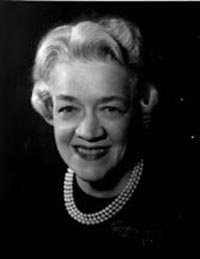
Margaret Chase Smith. From the US Senate Historical Office. Public domain via Wikimedia Commons.
Well, indeed, the voters of one of Maine’s three congressional districts had already taken a chance on a woman, electing Margaret Smith on five occasions since the death in 1940 of her husband, Representative Clyde Smith, whose dutiful secretary she had once been. During her more than eight years in the House, Mrs. Smith—who never missed an opportunity to associate herself with the 1939 film classic Mr. Smith Goes to Washington—initially built a record as an independent outsider, mirroring the Hollywood image of Jimmy Stewart’s “Senator Jefferson Smith.”
In 1948 the women of Maine, who constituted nearly two-thirds of that state’s registered voters, appreciated Smith’s efforts during World War II to bring equal status to women in the armed services. Some among them were particularly offended by her opponents’ questioning of women’s ability to hold public office.
With the campaign slogan, “Don’t trade a record for a promise,” Smith overwhelmingly won both the June Republican primary and the general election–at that time held in September. In that latter election, she benefitted from the cluelessness of her opponent, a dermatologist who argued that in a sick world, what the nation most needed were more physicians in government.
The first woman elected to both houses of Congress and the first woman to reach the Senate without previously having been appointed to an unexpired term, Mrs. Smith was the most nationally prominent Republican in her Senate freshmen class. Among her classmates were high-profile Democrats Lyndon Johnson of Texas and Hubert Humphrey of Minnesota.
It was customary for new senators of her day to remain quietly in the shadows. Not Senator Smith! In office less than a year-and-a-half, she delivered a blistering 15-minute floor speech against the anti-Communist demagoguery of Wisconsin Senator Joseph R. McCarthy. McCarthy responded predictably with a sneering reference to Smith and the co-signers of her “Declaration of Conscience” as “Snow White and the Six Dwarfs.”
Margaret Smith’s power in the Senate grew out of her independence—no party leader could take her vote for granted; her diligence—she made every roll-call vote for nearly twenty years until hip surgery broke that remarkable streak; her boundless energy; and her eventual seniority on the chamber’s influential committees on Appropriations and Armed Services. She dismissed efforts to brand her as a pioneering feminist. “I was treated fairly in the Senate not because of equal rights but because of seniority.”
From her Armed Services Committee perch, Smith adopted a hawkish approach to US military policy, supporting the war in Vietnam and criticizing the United States for not keeping ahead of the Soviet Union in stockpiling nuclear weapons. That stance provoked Soviet Premier Nikita Khrushchev to denounce her as “the devil in disguise of a woman.”
“Maggie” (a commonly used reference that she disliked) Smith’s path-breaking Senate career ended in 1972 with her defeat by Democrat William Hathaway. His campaign played on her apparent physical frailty, noting that she used a motor scooter to shuttle between her Senate office building suite and the Capitol (she would live for another 23 years), and charges of her remoteness from her constituents. Her retirement left the Senate an all-male bastion for the next five years.
Twenty years after Smith’s departure, the 1992 Senate elections witnessed a major national backlash against the traditionally male Senate. The result was the so-called Year of the Woman. This came in no small degree because of the shabby treatment the men of the Senate Judiciary Committee accorded to Anita Hill, who testified at its hearings in opposition to the US Supreme Court appointment of Clarence Thomas. As a result of that pivotal election, by mid-1993 seven women sat in the Senate. Today, that number stands at 20, including 16 Democrats and 4 Republicans. Currently, in California, New Hampshire, and Washington State, both senators are women, a status held by Smith’s Maine from 1997 until 2013.
Perhaps the greatest legacy of Margaret Chase Smith’s 1948 Senate election is that these 20 women are no longer viewed with the condescending curiosity that greeted the Mrs. Smith who went to Washington 65 years ago. Today, they are not primarily “women” senators; they are just senators.
The Margaret Chase Library in her hometown of Skowhegan, Maine, now serves as a robust research facility for those who wish learn more about her life, her times, and a US Senate largely unrecognizable to her modern successors.
Richard A. Baker, Historian Emeritus of the US Senate, is coauthor of The American Senate: An Insider’s History.
Subscribe to the OUPblog via email or RSS.
Subscribe to only American history articles on the OUPblog via email or RSS.
The post Why send a woman to Washington when you can get a man? appeared first on OUPblog.
Blog: The Open Book (Login to Add to MyJacketFlap)
JacketFlap tags: Holidays, Sports, baseball, biography, women's history month, guest blogger, women's history, Marcenia Lyle, toni stone, Add a tag
Since it’s Women’s History Month and baseball season is right around the corner (!), we asked our favorite sports expert, author Crystal Hubbard, whether she thought women should be allowed to play professional baseball. Here’s what she had to say:
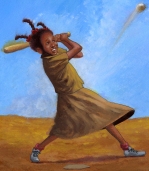 Pitcher Jackie Mitchell signed a contract to play for the Chattanooga Lookouts, a Southern Association minor league team, in 1931. This deal differed from most because Mitchell wasn’t like the other boys. She wasn’t a boy at all. She was a woman, one of the very few to play professional baseball on all-male teams. Although Mitchell struck out Babe Ruth and Lou Gehrig in an April 2, 1931 exhibition game against the New York Yankees soon after signing with the Lookouts, baseball commissioner Judge Kennesaw Mountain Landis canceled Mitchell’s contract, claiming that baseball was too strenuous for women. Commissioner Ford Frick, on June 21, 1952, officially banned women from professional baseball.
Pitcher Jackie Mitchell signed a contract to play for the Chattanooga Lookouts, a Southern Association minor league team, in 1931. This deal differed from most because Mitchell wasn’t like the other boys. She wasn’t a boy at all. She was a woman, one of the very few to play professional baseball on all-male teams. Although Mitchell struck out Babe Ruth and Lou Gehrig in an April 2, 1931 exhibition game against the New York Yankees soon after signing with the Lookouts, baseball commissioner Judge Kennesaw Mountain Landis canceled Mitchell’s contract, claiming that baseball was too strenuous for women. Commissioner Ford Frick, on June 21, 1952, officially banned women from professional baseball.
Marcenia “Toni Stone” Lyle, Ila Borders, and most recently, Eri Yoshida of Japan, are among the very few truly accomplished female baseball players who found spots on the rosters of professional male teams. In 1993, Carey Schueler—the daughter of then White Sox general manager Ron Schueler—was drafted by the White Sox, becoming at 18 years old the first woman ever drafted by a Major League team.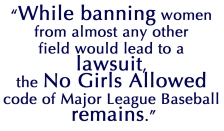
Schueler, a left-handed pitcher, never took the field for a game.
While banning women from almost any other field would lead to a lawsuit, the No Girls Allowed code of Major League Baseball remains. Is it because women are too delicate for the physical challenges of MLB, or because they don’t have the physical ability or talent? Some women, perhaps. But not all, as evidenced by Mitchell, Lyle, Borders, Yoshida, and a fresh generation of skilled female Little Leaguers.
The same physical limitations used to justify banning women from professional baseball can also be applied to most male players—they aren’t strong enough, they aren’t fast enough, they aren’t good enough. Some female athletes are strong enough. And fast enough and good enough. Yet they still don’t have the same opportunities their male contemporaries enjoy. Male athletes who play baseball well have the chance to earn scholarships to college and perhaps even play professionally. Female athletes deserve the same.
No capable athlete should be banned from the Major Leagues because of her gender. Diamonds are a girl’s best friend. It’s long past time we redefined that saying.
Crystal Hubbard is a sports buff and full-time writer. Her books include Catching the Moon: The Story of a Young Girl’s Baseball Dream, Game, Set, Match, Champion Arthur Ashe, and The Last Black King of the Kentucky Derby.
Filed under: guest blogger, Holidays Tagged: baseball, biography, Marcenia Lyle, Sports, toni stone, women's history, women's history month
Blog: The Open Book (Login to Add to MyJacketFlap)
JacketFlap tags: Holidays, women, Book Lists, women's history month, overcoming obstacles, women's history, dreams and aspirations, Add a tag
In honor of Women’s History Month (and International Women’s Day, which is today!), we’ve pinned a roundup of our titles that feature some pretty amazing women on Pinterest. Check out our board and be inspired to make your mark in history!
Filed under: Holidays Tagged: Book Lists, dreams and aspirations, overcoming obstacles, women, women's history, women's history month
Blog: Book Love (Login to Add to MyJacketFlap)
JacketFlap tags: nonfiction, animals, BOB, women's history, fearless female, Add a tag
Temple Grandin: How the Girl Who Loved Cows Embraced Autism and Changed the World by Sy Montgomery, Houghton Mifflin Books for Children, 2012, 148 pp, ISBN: 0547443153
Temple Grandin was diagnosed with autism in 1950, not even a decade after the term "autism" had been coined for the very first time. As the spectrum disorder was still so new, very few people had any understanding of what that diagnosis meant - including Temple's own father, who called her "retarded" and wanted to send her away to a mental institution.
But that didn't slow Temple down for a second. Through the support and encouragement of her mother, and some truly stellar teachers, Temple went on to become an inventor, an activist, a college professor, and a source of real life inspiration for thousands around the world.
Review:
Book lovers, I hope you're still with me, because you've got to hear this... Sy Montgomery's book was at the bottom of my BOB list. I already knew a fair amount of Temple's story because my 6th graders had studied her when we were still in Baltimore. And after just finishing Titanic, I was itching for a novel to immerse myself in. But for some reason this title just kept rising to the top of my library bag. So I picked it up. And polished it off in less than 24 hours. Y'all, this book is excellent.
Temple Grandin's life is nothing short of remarkable. She didn't even speak until years later than her peers. As a child, she spent hours twirling in circles. Just the sound of a fan could cause her physical pain. But guess what? As of today, Temple has gone on to be a wildly successful adult, known around the world for her inventions that advance the humane treatment of animals. She is literally the only person ever to be honored by People for the Ethical Treatment of Animals (PETA) and inducted into the Meat Industry Hall of Fame. Just think about that for a second.
I read a lot of Temple's story in the car, and stopped at least every five minutes to feed my husband another fact about her incredible life. This is the kind of real life read that is just too good to keep to yourself - it needs to be shared.
And I will be the very first to admit that nonfiction can be a hard sell - especially to students! But the book designer, Cara Llewellyn, did a phenomenal job of creating a book that sells itself. Every single page features bright colors, contemporary fonts, and eye-catching illustrations and photographs. Temple Grandin is as much of a pleasure to look at as it is to actually read.
Recommendation:
If you appreciate nonfiction and/or biographies, you're going to love this one. But even if you're a die-hard fiction fan, I would still whole-heartedly recommend that you give Temple Grandin a shot.
BOB Prediction:
I'm one of Augustus and Hazel's biggest fans so it pains me a little to say this... but I can see Temple giving them a run for their money in the first round. There are few things more powerful than a story that is inspiring, engaging, and TRUE.
Quotable Quotes:
"That's right. I want you to count the moos." - Temple Grandin
"I must conquer my fears and not let them block my way." - Temple Grandin
Blog: The Fourth Musketeer (Login to Add to MyJacketFlap)
JacketFlap tags: biography, women's history, picture-book, Add a tag
Recommended for ages 6-12.
Release date: March 5, 2013
In her debut book for children, author Jan Pinborough offers a charming picture book biography of Anne Carroll Moore, an individual not well known among the general public but whose advocacy of library services for children are worthy of being celebrated in this handsome new volume released just in time for Women's History Month.
The book begins almost like a fairy tale: "Once in a big house in Limerick, Maine, there lived a little girl named Annie Carroll Moore. She had large gray eyes, seven older brothers, and ideas of her own." We soon learn that Annie is a bit of a rebel, not content to do what a girl was supposed to do in those days. She loved books, but in those days children weren't allowed in the library. When she grew up, she went to New York City on her own to enroll in library school, and soon went to work in a library where they had something brand new--a room just for children, where Annie even read aloud to them. An advocate for children, she later became head of the children's rooms at the New York Public Library's many branches. At this time, children weren't allowed to take books home, since the librarians thought the children wouldn't bring them back.
Pinborough portrays Anne Carroll Moore's feisty personality with a constant refrain in the book: "Miss Moore thought otherwise." When a grand new central library was built in the city of New York, Miss Moore was responsible for creating and designing the special place for children, complete with child-sized furniture. She brought authors, musicians and storytellers to entertain the children, and entertained them herself with her special doll Nicholas Knickerbocker and stories of his life. Even when she retired, she continued educating librarians across the country on how to create wonderful libraries for children.
Back matter includes more details about Miss Moore, the "trailblazing librarian," and a list of sources.
The lively artwork by Debby Atwell, executed with brightly colored acrylics in a folk-art influenced style, is a wonderful match for Pinborough's breezy writing style. Every children's librarian will want to have a copy of Pinborough's tribute to this remarkable woman on his or her shelf. She was a true hero for librarians and children everywhere! Check out the special website devoted to the book, an interview with the illustrator, Debby Atwell, at Kidsbiographers Blog, and watch for a special post by Jan Pinborough on Kidlit Celebrates Women's History Month on March 7!
Blog: Book Love (Login to Add to MyJacketFlap)
JacketFlap tags: historical fiction, world war II, BOB, Printz Honor, women's history, fearless female, Add a tag
Code Name Verity by Elizabeth Wein, Hyperion Book CH, 2012, 352 pp, ISBN: 1423152190
Imagine yourself a prisoner of war. Your plane was shot down in Nazi occupied France. All of your clothes have been taken away. An iron rod has been tied to your back. You are tortured on a daily basis. How long would it take you to break?
And when you started talking, what story would you tell?
It took me two attempts to read Code Name Verity. Not because I couldn't get into the first time - quite the opposite in fact. My first attempt was the audiobook, read by the immensely talented Morven Christie and Lucy Gaskell (although I didn't quite make it to Gaskell's portion). Christie was the voice of "Verity" and her gorgeous Scottish brogue made the book for me. I can still hear her spitting out "mein Hauptsturmführer von Linden," and goodness knows I would have completely muddled up that pronunciation had I been reading all on my own. Christie did an absolutely brilliant job of nailing down each nuance and innuendo of Verity's story, all through the power of her voice.
Now, when I started reading/listening to Code Name Verity, I didn't know a single thing about the story except that it was generating a ton of positive buzz in the book world. **Possible spoiler alert: When Verity's section abruptly ended and Maddie's began, I was so upset that I immediately ejected the CD and took it straight back to the library. Why was Elizabeth Wein taking Verity away??? Bring her back!!!
Well, about a week later, I was burning up to know how the book ended. So I checked out the print version from the library - hence, my second attempt. And I actually just started fresh from the very beginning. Seriously, this story does not get old. And I picked up on so many more things on the second read-through! So, I would consider the second attempt a big success. When I got to Maddie's story again, I was ready. And then Maddie had to go and blow my mind. Verity wasn't gone by a long shot, and her story just took a very dramatic twist when it picked up with her best friend. Elizabeth Wein, I take back what I said before. You are a genius.
If you love a mystery, if you appreciate historical fiction, if you get into a girl power story, if you are simply a human being who loves to read... do not pass up Code Name Verity.
BOB Prediction:
Code Name Verity is going straight to the Big Kahuna Round. I will be pretty shocked if it doesn't win the whole thing.
"I have told the truth." - Verity
(If you've read it, doesn't this line still just give you the chills??)
Blog: Shelf-employed (Login to Add to MyJacketFlap)
JacketFlap tags: YA, nonfiction, J, Non-Fiction Monday, Women's history, compendiums, Add a tag
 |
| Illustration copyright © 2013 by Rebecca Guay |
Just in time for Women's History Month, the mother-daughter duo of Jane Yolen and Heidi E. Y. Stemple has released a fun compendium of "bad" women in history. From Delilah, the stealthy hairstylist of the Bible (circa 110BC), to gangsters' gal, Virginia Hill (1916-1966), Yolen and Stemple highlight history's most rebellious, racy, raucous, reprehensible, and sometimes resourceful women.
The choice of subjects, twenty-six in all, isn't the only thing that makes Bad Girls: Sirens, Jezebels, Murderesses, Thieves, and other Female Villains a unique addition to the collection of books on women in history. Illustrations are provided by Rebecca Guay. In addition to a comic portrait of each notorious woman,
 |
| "Cleopatra" Illustration copyright © 2013 by Rebecca Guay |
Resources are included, offering interested older readers a jump start on where to find further information. There is more than just fun to be had with Bad Girls; download these resources from the publisher's site:
Blog: The Fourth Musketeer (Login to Add to MyJacketFlap)
JacketFlap tags: biography, African-American history, women's history, Add a tag
Recommended for ages 7-12.
Candlewick has recently reissued in beautiful full-color paperback editions several biographies of famous African-American women by Kathryn Lasky. Earlier this month I reviewed Vision of Beauty: The Story of Sarah Breedlove Walker. In A Voice of Her Own, Lasky shares the story of an equally extraordinary woman, Phillis Wheatley, known as the first black woman poet in America.
Lasky begins her book as a young girl is kidnapped from Africa and sold into slavery in America in 1761. Through the girl's eyes, Lasky describes the harrowing journey from the west coast of Africa. A powerful illustration, painted in acrylics, shows a terrified young girl huddled in the hold of the ship. Upon arrival, she is purchased at a Boston slave market by the Wheatley family and given the name Phillis. When we next meet Phillis, we learn that she has become no ordinary slave. Mrs. Wheatley, realizing quickly how bright her new young slave was, decided to teach her to read and write, a sort of social experiment to see if an African could learn and understand the Bible. While this sort of instruction was not illegal as it was in the South, it was nevertheless never done.
Phillis proved to be such an able student that she progressed beyond English to Latin and Greek, geography and mathematics--this at a time when few white women were offered this sort of education, and only the elite among white men. Phillis was especially attracted to poetry, and had her first poem published when she was only fourteen years old. Phillis became a celebrity in Boston, and was trotted out by her mistress to all the finest houses in town as a sort of curiosity.
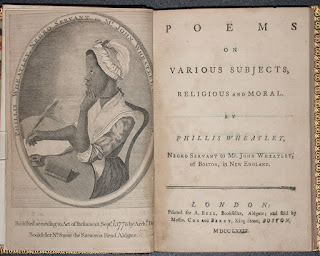 |
Phillis Wheatley. Poems on Various Subjects. London, 1783 |
In an epilogue, Lasky relates briefly the last years of Wheatley's life; after receiving papers freeing her from slavery from the Wheatleys, she married and had three children, all of whom died in infancy. Her final poem, "Liberty and Peace," celebrated the end of the war, and she died in poverty at the age of thirty-one.
Back matter includes an index and a list of selected sources, as well as notes from the author and illustrator. The text includes a few brief quotations from Wheatley's poems.
At a brief 38 pages, with beautiful and abundant color illustrations, this very accessible biography is one step up from a picture book, and could be read aloud in class or by parents as well as read independently by students in about third grade and up. While the author provides plenty of information for a biographical report, the subject matter is fascinating and suitable for general reading as well as school assignments. Phillis Wheatley's remarkable rise from an illiterate slave to a literary figure celebrated on both sides of the Atlantic is an inspiration to share with children, particularly during Black History Month or Women's History Month.
Blog: Shelf-employed (Login to Add to MyJacketFlap)
JacketFlap tags: nonfiction, Non-Fiction Monday, announcement, Women's history, Add a tag
The popular, not-for-profit, educational Women’s History Month website returns in March!
Now in its third consecutive year, the blog, KidLit Celebrates Women’s History Month founded by me and fellow librarian, Margo Tanenbaum, of The Fourth Musketeer, brings together distinguished authors and illustrators of books related to women’s history with librarians and bloggers from across North America.
Each day features a new essay, commentary or review by some of the most noted writers in the field of literature for young people. Contributors for 2013 include Jane Yolen, Sy Montgomery, Roger Sutton, Tanya Anderson, Michelle Markel and Kathleen Krull, among others.
The blog will publish daily from March 1 through March 31, and will once again feature original posts from well-known, award-winning writers, illustrators, and bloggers. A complete lineup of contributors may be found on the site. Interested readers can sign up to “follow” the blog, or receive it via email. Visit the site at http://kidlitwhm.blogspot.com to see “following” options, an archive of past contributions, and links to educational resources. Don't miss a single day. It's going to be a great month!
I am this week's host of the weekly Nonfiction Monday meme, a weekly gathering of bloggers who discuss nonfiction books for children each Monday.
Here at Shelf-employed, I will feature links and descriptions to each participating blog. Please check back later or tomorrow to see all of today's contributions to Nonfiction Monday. Thanks so much.
Blog: The Fourth Musketeer (Login to Add to MyJacketFlap)
JacketFlap tags: women's history, picture-book, biography, immigrants, Add a tag
Recommended for ages 7 and up.
Get a jump on Women's History Month with this new picture book about Clara Lemlich, a remarkable 20th century labor leader. Its author, Michelle Markel, will be contributing a post to 2013's Kidlit Celebrates Women's History Month, so don't forget to sign up to follow the blog so you don't miss any of the fascinating posts!
Picture books about early 20th century Jewish women labor leaders are not exactly published every day in the picture book universe, so I was especially eager to read this new work, illustrated by award-winning illustrator Melissa Sweet, about Clara Lemlich, best known for organizing the shirtwaist makers' strike of 1909.
We first meet Clara as she is arriving in the United States, part of the mass of immigrants. But Clara is different--she's "got grit, and she's going to prove it. Look out, New York!"
Social justice is an overriding theme of this book, and we see through Clara's eyes the injustices of life in early 20th century America for the impoverished immigrants. "This was not the America she'd imagined." Girls are hired to make blouses for a few dollars a month, wages desperately needed to help support their families. Markel vividly describes the factories in just a few words--only two toilets, one sink, and three towels for 300 girls to share, and better not be a few minutes late or bleed on a piece of cloth if you've pricked your finger or you'll lose half a day's pay or even be fired.
But little Clara Lemlich is not one to sit back and take it. She organizes strikes, and despite being arrested repeatedly, and beaten, she is not easily silenced. But she realizes that a general strike of all the garment workers is what's needed to make the bosses stand up and take notice, and at a union meeting, she calls for women to launch the largest walk-out ever.
Clara is the leader of the Revolt of the Girls, as the newspapers call it. And eventually the owners meet some of their demands, including a shortened work week and better wages. Markel ends her elegie to Lemlich on a hopeful note, emphasizing how Clara's actions helped thousands of workers. "proving that in America, wrongs can be righted, warriors can wear skirts and blouses, and the bravest hearts may beat in girls only five feet tall."
An afterword provides further details about the history of the garment industry, and the role of Jewish immigrants in the business. Strangely enough, Clara is never identified as Jewish in the main text of the book, although she is shown shouting in Yiddish for a general strike. Back matter also includes a selected bibliography of general and primary sources. I would have also liked to have seen something on Clara Lemlich's later life. For example, she continued advocating for the oppressed her entire life, even helping to organize nursing home orderlies in the retirement home where she spent the end of her life.
 |
| Clara Lemlich |
Melissa Sweet's remarkable illustrations integrate the garment industry in a very literal fashion into her depiction of Clara's life. She uses watercolor, gouache, and mixed media, and pieces of fabric and sewing machine stitching are front and center in nearly every illustration. Some of the illustrations are particularly moving, including the one in which rows and rows of factory workers are shown from directly above, with the hundreds of girls appearing faceless and indistinct from each other like cogs in a wheel. I also loved the "girl power" illustration of Clara calling for a general strike--Sweet depicts Clara from behind, with hundreds of people in the audience raising their fists in solidarity and with her call for a strike in an oversized text balloon, with the word "Strayk!" (or strike!) in bright red lettering!
This is a must-have for anyone interested in exposing their children to important issues and people in the social justice movement, as well as outstanding women in history, those who chose to try to make a difference in an era when women were encouraged to make their dominion at home. To learn more about Clara Lemlich, consult Markel's bibliography or check out the entry in the Jewish Women's archive on-line.
Blog: The Fourth Musketeer (Login to Add to MyJacketFlap)
JacketFlap tags: biography, African-American history, women's history, 1900-1940, Add a tag
Recommended for ages 7-12.
Candlewick Press has recently reissued in paperback Kathryn Lasky's biography of Sarah Breedlove Walker, originally published in 2000. In a brief 48 pages, Lasky chronicles the life of this remarkable woman, born into poverty to former slaves, who became a highly successful entrepreneur and philanthropist. Orphaned at the age of seven, Sarah had a difficult childhood, and married at the age of 14 to escape living with her sister and her cruel husband. She eventually moved to St. Louis where she worked as a laundress and diligently saved to be able to give her daughter the education she never had.
Because of poor nutrition, Sarah's hair began to fall out, and she began to work on a formula that would produce healthy hair for African-American women. After testing her products on herself, she began selling door-to-door, and eventually expanded her products into the Madam C. J. Walker Manufacturing Company, a business empire which made her the wealthiest black woman in America.
In a brief, easy to read narrative, Lasky hits on the highlights of Walker's life, emphasizing how remarkable her success was in an era when she had two strikes against her--being female and being black. My favorite scene in the book involves Waker attending a conference of African-American business leaders, all of whom (of course!) were men. Lasky describes how Walker tried unsuccessfully to get the attention of Booker T. Washington, so that she could speak. She finally sprang to her feet, relating how she came from the cotton fields of the South, promoting herself into the business of manufacturing hair goods. "'My object in life is not simply to make money for myself, but to use part of what I make in trying to help others,' continued Madam Walker...With these words, Madam Walker proved herself more than equal to any man in that room."
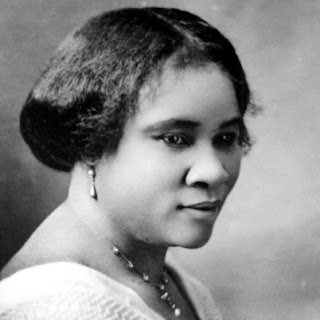 |
| Sarah Breedlove Walker |
Abundantly illustrated with beautiful full color watercolor paintings by Nneka Bennett, Lasky's book is an inspirational tale that could be read aloud or read independently by children in elementary school.
Blog: The Fourth Musketeer (Login to Add to MyJacketFlap)
JacketFlap tags: young adult, England, 19th century, women's history, Add a tag
Release date: January 1, 2013
Recommended for ages 10 and up.
Carolyn Meyer's series The Young Royals has examined the youth of many of history's most prominent royal female figures, including Queen Elizabeth I, Marie Antoinette, and Cleopatra. It's perhaps inevitable that she would turn her attention to the most important female queen of the 19th century, a figure so prominent she gave her name to an entire historical period, Queen Victoria. The book spans from 1827, when Victoria was eight years old, to 1843, by which time Victoria was a young queen with three children.
Meyer tells her story through diary entries based on Victoria's own diaries, which she began keeping at the age of thirteen. (Note: in 2012, the entire contents of these diaries were made available online). T As Meyer explains in an afterword, these diary entries were written in the knowledge that they would be read, at first by her mother and governess, and later by historians. Meyer uses her imagination (and research of course) to describe what Victoria is really feeling, but incorporates many of Victoria's stylistic quirks, such as an affection for writing in all capitals or underlining dramatically, to give the feel of her actual diaries.
I really enjoyed this novel, and felt it did a terrific job of capturing Victoria's strong personality and opinions, both as a young girl and as an adult. We learn many details of Victoria's daily life, from her strained relationship with her mother and her advisor, Sir John, to her attachment to Dash, her mother's King Charles Spaniel. Even when you're a privileged princess, you don't necessarily get your way, and Victoria's wishes are often thwarted by her mother or court intrigue. Even when she becomes queen, her struggles with her mother are not over, although Victoria takes control of many aspects of her court, including her personal household. In addition to dealing with all the intrigues of court life, Meyer also takes us into Victoria's confidence as she is wooed by and eventually weds her cousin Albert, the love of her life. Even with Albert, however, there were inevitable conflicts, as the young couple tried to adjust to their different roles--queen, sovereign, wife, and mother, and prince consort, husband, and father.
An afterword provides additional information on the rest of Victoria's life and other historical notes, as well as a bibliography and a list of related websites to visit.
Those who read this novel should certainly get a copy of the DVD of The Young Victoria, the beautifully realized 2009 film starring an elegant Emily Blunt as the young monarch. Another appealing novel for young readers with the young Victoria as a prominent character is Prisoners in the Palace by Michaela Maccoll (Chronicle, 2010).
Disclosure: advance copy provided by publisher.
Blog: The Fourth Musketeer (Login to Add to MyJacketFlap)
JacketFlap tags: young adult, Civil War, women's history, Add a tag
Recommended for ages 12 and up.
Laurie Halse Anderson once wrote in her blog that she preferred to call her historical books "historical thrillers" rather than "historical fiction," given that many kids and teens associate historical fiction with BORING. However, it's not every historical fiction title that can be justly called a "thriller." With A Soldier's Secret, Marissa Moss definitely joins the club of historical thriller writers for teens. Based on the true story of Civil War hero Sarah Edmonds, who enlisted in the Union Army as Frank Thompson, this is one story so full of incredible twists and turns that readers will be compelled have to finish it just to find out what happens.
In this novel, Moss returns to explore in greater depth Sarah Edmonds' life, which she portrayed in the lively 2011 picture book biography Nurse, Soldier, Spy. When we meet Sarah at the opening of this novel, it's the spring of 1861, and she has been living as Frank Thompson, a traveling book salesman, for more than three years. Writing in the first person, Sarah fills the reader in on her back story growing up on a farm in New Brunswick, Canada, with a cruel and abusive father; when her father is about to force her into an unwanted marriage, Sarah cuts her hair, dresses as a boy, and runs away, ending up in the United States.
But when the war breaks out, the teenaged Sarah wants to be a part of history, and enlists in the Union Army as Private Frank Thompson, Army nurse. An accomplished shot and rider, she is especially skilled at hiding her female parts when she "does her business," and no one questions her sex or her ability as a soldier. Moss does an excellent job portraying the tedium and occasional terror of a soldier's existence through Sarah's eyes, as she wonders if she will be able to measure up in battle. When the Union loses the first Battle of Bull Run, Sarah/Frank no longer needs to wonder; she's running around helping the doctors amputate limbs, writing letters to loved ones, and carrying out the last wishes of dying soldiers, as the reader gets a close-up view of the primitive nature of medical care in the 19th century.
But of course Sarah is a woman, and living in close proximity with so many eligible young men, the inevitable happens--she develops romantic feelings for a fellow soldier, fantasizing about him. Eventually her feelings are so strong, she asks for a reassignment, next serving as a postmaster delivering letters to the troops. Soon she is recruited as a Union spy, where her skill at disguises comes in very handy. She even "disguises" herself as a woman for one of her assignments!
While there are hundreds of documented cases of women disguising themselves as men to fight in the Civil War, Sarah was the only woman to be recognized by Congress as an honorably discharged soldier, with rights to back pay and pension, and the only woman allowed to join the association for Civil War veterans. At her death she was granted a military funeral and buried in a cemetery for Civil War veterans.
Moss' well-researched novel is based in part on Sarah Edmonds' own memoir, as well as many other sources on women in the Civil War and the Civil War in general. Moss includes extensive back matter, including background on Sarah Edmonds, brief biographies of Union Army officers, a brief Civil War timeline, which includes annotations for battles in which Frank/Sarah participated, and selected bibliography.

Blog: The Fourth Musketeer (Login to Add to MyJacketFlap)
JacketFlap tags: biography, women's history, Add a tag
Recommended for ages 9 to 14.
Release date: October 23, 2012
The two most famous works by Charlotte and Emily Bronte--Jane Eyre and Wuthering Heights--are classics of English literature, and have been frequently adapted for the movies and television as well. But the lives of their authors, and of their sister, Anne, author of Agnes Grey, are perhaps not as well known, especially to young readers. Author Catherine Reef, who published the very well-reviewed biography for young people Jane Austen: A Life Revealed, in 2011, has turned her attention to the tragic lives of the Brontes in her newest work.
Reef's writing style is easy to read, with a narrative flair that makes the Brontes lives read much like a novel. The biography opens when their father, Patrick, a country minister, was left to raise six small children when his wife died soon after the birth of their youngest, Anne. Although he hoped to marry again, and proposed to several women, "none wanted a husband with a small income and a large family." The children grew up in the wilds of Northern England, exploring the moors. Because the children had only themselves for playmates, they developed an elaborate fantasy universe, complete with imaginary lands acted out by a set of toy soldiers.
The 19th century had few options for "respectable" women, and with no dowries for his daughters, Patrick Bronte sent his daughters to train to be teachers so they could provide for themselves after his death (ironically he outlived all six of his children). When the two eldest die of tuberculosis, caught at the horrible school they attended, the surviving girls and their brother Branwell were educated at home, where they studied the classics as well as contemporary 19th century Romantic poets like Byron and Wordsworth.
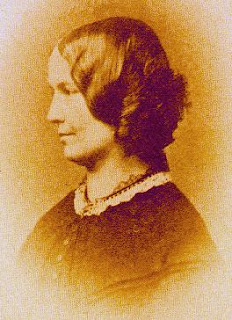 |
| Charlotte Bronte, 1854 |
All of the Bronte siblings were deeply creative, from Branwell, an artist who was ruined by drink and opium addiction, to the women, who were all talented writers. However, women were not meant to be authors in the 19th century, and all were forced to publish their works under male pseudonyms. Charlotte, under the name Currer Bell, was the first to be published, with Jane Eyre, in 1847.
In the course of this group biography, Reef provides summaries of the Brontes' major novels, including the lesser-known Agnes Grey as well as analysis of their novels' themes, historical importance, and current interpretations. She also situates the novels in the context of women's history, stating that Charlotte Bronte "had written frankly about a women's feelings at a depth no other writer had yet explored." Reef also writes especially movingly about the terrible year of 1849, in which Branwell, Emily, and Anne all die in eight months, leaving their sister Charlotte as the only survivor of the original six children. She, too, was destined to meet an early and tragic death; not long after getting married, and finally knowing a brief period of happiness, she too, died, at the age of 38.
This well researched book is abundantly illustrated with photographs, portraits, and illustrations from the Brontes' novels. Back matter includes a detailed bibliography, end notes, and index, and a list of the works of Charlotte, Emily, and Anne Bronte, including references to published editions of their letters and their childhood writings.
The brief length (190 pages) and accessible style of this biography make it eminently suitable for school and public libraries, where it could be a useful resource for school reports. Although the length means that readers don't get an in-depth portrait of any of the Brontes, the book is a well done introduction that may spark further reading among young readers.
 |
| Jane Eyre, 2006 BBC production |
Readers, what is your favorite adaptation of a Bronte novel? Leave a comment below. Wuthering Heights alone has been adapted more than 30 times for film, TV, radio, and even opera. My favorite adaptation is the Jane Eyre miniseries done for Masterpiece Theatre in 2006, starring Ruth Wilson and Toby Stephens. Much better than the 2011 movie, which had to leave so much out! Check it out on DVD from Netflix or your local library. And watch for a new version of Wuthering Heights to be released this fall, the first time Heathcliff is depicted by a black actor. I can't wait to see that one!
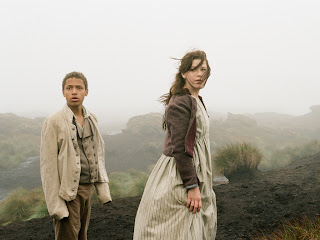 |
| Scene from Andrea Arnold's new adaptation of Wuthering Heights |
Blog: The Children's Book Review (Login to Add to MyJacketFlap)
JacketFlap tags: Giveaways, Helen Keller, Annie Sullivan, Deborah Hopkinson, Women's History, Raul Colón, Add a tag
By Bianca Schulze, The Children’s Book Review
Published: September 9, 2012
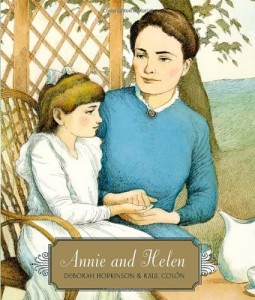 Enter to win a copy of Deborah Hopkinson’s biographical picture book Annie and Helen; illustrated by Raul Colon.
Enter to win a copy of Deborah Hopkinson’s biographical picture book Annie and Helen; illustrated by Raul Colon.
An original new book about two amazing women from history, Annie Sullivan and Helen Keller.
Giveaway begins September 9, 2012, at 12:01 A.M. PST and ends October 7, 2012, at 11:59 P.M. PST.
Reading level: Ages 4-8
Hardcover: 48 pages
Overview
Author Deborah Hopkinson and illustrator Raul Colón present the story of Helen Keller in a fresh and original way that is perfect for young children. Focusing on the relationship between Helen and her teacher, Annie Sullivan, the book is interspersed with excerpts of Annie’s letters home, written as she struggled with her angry, wild pupil. But slowly, with devotion and determination, Annie teaches Helen finger spelling and braille, letters, and sentences. As Helen comes to understand language and starts to communicate, she connects for the first time with her family and the world around her. The lyrical text and exquisite art will make this fascinating story a favorite with young readers. Children will also enjoy learning the Braille alphabet, which is embossed on the back cover of the jacket.
About the Author
DEBORAH HOPKINSON is the author, most recently, of A Boy Called Dickens. She has written numerous other books, including Sky Boys: How They Built the Empire State Building, an ALA Notable Book and a Boston Globe-Horn BookHonor Book; Abe Lincoln Crosses a Creek, an ALA Notable Book and a Junior Library Guild Selection; and the ALA Notable Apples to Oregon. Her many other acclaimed titles include Under the Quilt of Night and Fannie in the Kitchen. Visit: http://www.deborahhopkinson.com
How to Enter
- Fill out the required fields below
- Enter once daily
Giveaway Rules
- Shipping Guidelines: This book giveaway is open to participants in the United States only.
- Giveaway begins September 9, 2012, at 12:01 A.M. PST and ends October 7, 2012, at 11:59 P.M. PST, when all entries must be received. No purchase necessary. See official rules for details. View our privacy policy.
Prizing courtesy of Random House Children’s Books.
Original article: Giveaway: Annie and Helen by Deborah Hopkinson
©2012 The Childrens Book Review. All Rights Reserved.
Add a CommentBlog: The Children's Book Review (Login to Add to MyJacketFlap)
JacketFlap tags: Writing Resources, Ages 4-8, Picture Books, Biographies, Helen Keller, Annie Sullivan, Books for Girls, Deborah Hopkinson, Women's History, Cultural Wisdom, Add a tag
By Deborah Hopkinson, for The Children’s Book Review
Published: September 9, 2012
Recently I had the opportunity at my day job (I’m vice president for advancement at Pacific Northwest College of Art in Portland, Oregon) to take the popular “Strengths Finder” test. My top strength turned out to be “Learner.”
I’d have to say that’s a fairly accurate description. It also explains much about how I choose the subjects I write about in my nonfiction and historical fiction for young readers. I have wide-ranging reading interests (I like to read with my story antennas up). When I’m learning something new, I’m engaged, enthuse, and happy. And then there are those magical moments when I come across something extraordinary that makes me sit up and say, “Wow! How come I never knew that before?” Whenever this happens, there’s a good chance I want to write about it.
 That’s certainly true with my new nonfiction picture book, Annie and Helen, illustrated by Raul Colon. Like most people I knew the general outlines of Helen Keller’s life, and I was familiar with the iconic moment at the water pump. But I knew very little of Annie Sullivan, or the details of her actual teaching methods. What I found was astonishing – so astonishing I wanted to share it with young readers.
That’s certainly true with my new nonfiction picture book, Annie and Helen, illustrated by Raul Colon. Like most people I knew the general outlines of Helen Keller’s life, and I was familiar with the iconic moment at the water pump. But I knew very little of Annie Sullivan, or the details of her actual teaching methods. What I found was astonishing – so astonishing I wanted to share it with young readers.
When I first began researching this book, I actually focused more on Annie Sullivan, whose early life was fraught with hardship. After her mother’s death, she and her little brother were put in an almshouse in Tewksbury, Massachusetts, where her brother later died. Annie, who’d become almost blind herself from trachoma, was able to go to the Perkins School for the Blind when she was 14. Operations partially restored her sight and she graduated in 1886 at the top of her class. The next spring, not quite 21, she set off alone from New England by train to take her first job: teaching a young deaf and blind child in Alabama named Helen Keller.
Annie Sullivan invented her own teaching methods, and that’s what I ultimately decided to write about in Annie and Helen. The book includes excerpts from Annie’s letters to her friend and former house mother, Mrs. Sophia Hopkins. The letters chronicle Helen’s progress and show how inventive and resourceful Annie was as she helped Helen make sense of the world through language. That spring must have been exhilarating for both teacher and student: by July, Helen had mastered enough skills to write a simple letter.
Annie and Helen is not a “cradle to grave biography.” Instead, it covers the period of March-July 1887, when teacher and pupil forged their incredible relationship. While I have written traditional biographies for very young readers on John Adams and Susan B. Anthony, and on Charles Darwin for slightly older readers, I often prefer to focus on a specific incident or a time period in order to illuminate someone’s life. Keep On! focuses on Matthew Henson’s early life and Arctic explorations, A Band of Angels is about Ella Sheppard’s experiences as a Jubilee Singer, and A Boy Called Dickens shows Dickens at age 12, when he was working in a blacking factory.
My books also include both nonfiction and historical fiction. My 2012 title, Titanic: Voices from the Disaster is nonfiction. But rather than write a biography of Dr. John Snow, the pioneering epidemiologist who proved that cholera was spread by water, I chose to fictionalize the story in my forthcoming middle grade novel, The Great Trouble, A Mystery of London, the Blue Death, and a Boy Called Eel. Hopefully readers will enjoy the story, and also there’s a long author’s note included if they want to know more.
I hope I will also be a reader who wants to know more. And perhaps that’s also a reason for choosing to write about Helen Keller. What better inspiration for the love of learning could there be?
To find out more about Deborah Hopkinson’s books, visit: www.deborahhopkinson.com
You can also discover more by following along on the Annie and Helen Blog Tour
September 1st: Watch. Connect. Read
September 1st: SharpRead
September 2nd: Nerdy Book Club
September 3rd: Bakers and Astronauts
September 4th: Two Writing Teachers
September 5th: Cracking the Cover
September 6th: Teach Mentor Texts
September 7th: Nonfiction Detectives
September 8th: Booking Mama
September 9th: Children’s Book Review
September 10th: Random Acts of Reading
September 11th: 7 Impossible Things Before Breakfast
Original article: Why Helen Keller? Selecting Subjects for Biographies
©2012 The Childrens Book Review. All Rights Reserved.
Add a CommentBlog: Shelf-employed (Login to Add to MyJacketFlap)
JacketFlap tags: explorers, bio, Women's history, marine life, book review, nonfiction, science, ocean, ecology, Non-Fiction Monday, picture books for older readers, Add a tag
I've just returned from vacation and have some catching up to do, but I didn't want to let Nonfiction Monday pass by without highlighting Claire A. Nivola's beautiful picture book, Life in the Ocean: The Story of Oceanographer Sylvia Earle. 
Nivola, Claire A. 2012. Life in the Ocean: The Story of Oceanographer Sylvia Earle. New York: Farrar Straus Giroux.
Born in 1935, Sylvia Earle rode in a single passenger airplane at the age of 5, was diving by the age of 16, went on an expedition in the Indian Ocean (the only female member of the expedition!), helped design a submersible diving bubble, once lived for 2 weeks under water, and served as the chief scientist at the National Oceanic and Atmospheric Administration (NOAA).
Ostensibly a biographical story of the admirable, Sylvia Earle, Life in the Ocean: The Story of Oceanographer Sylvia Earle is this and more.
Life in the Ocean inspires the reader to follow his dreams, wherever they may lead, and for the reader already interested in the natural world, and marine environments in particular, Life in the Ocean calls him to explore,
We have explored only 5 percent of the ocean. We know more about the planets in outer space than we know about the sea on our very own home planet!Claire Nivola's detailed paintings illustrate her intense interest in the natural world, showing even a lone mussel or skate egg sac on the ocean floor. Most of the illustrations are large and surrounded by white space, offset by manageable blocks of text in a simple font. However, smaller square illustrations are used to highlight the two more biographical pages of the book - each square featuring a milestone in Earle's life. The painting of a humpback whale swimming past Sylvia is stunningly serene, but calls to mind our individual insignificance on the planet. Check out Macmillan's Flickr gallery of artwork from Life in the Ocean to see this (though truncated) and many other illustrations from the book.
A lengthy and illustrated Author's Note contains additional information on Sylvia Earle and the current state of the earth's oceans. A Selected Bibliography rounds out this engaging and informational text.
Beautiful, inspiring and enlightening. Highly recommended.
Other reviews @
Waking Brain Cells
Kirkus Reviews
While Sylvia Earle may have "lost her heart to the water," after leaving her home in New Jersey for Florida, the ocean here in New Jersey is also a source of constant wonder, where my family has enjoyed sighting whales, dolphins, bio luminescent creatures lighting up the evening breakers, wave-surfing manta rays, and all manner of other more mundane, but nonetheless fascinating creatures. Life in the Ocean reminds me that these everyday marvels may not always be so. They need our support as well as our admiration.
|
4 Comments on Life in the Ocean - a review, last added: 4/16/2012
Display Comments
Add a Comment
Blog: The Fourth Musketeer (Login to Add to MyJacketFlap) JacketFlap tags: sports, biography, African-American history, women's history, picture-book, Add a tag
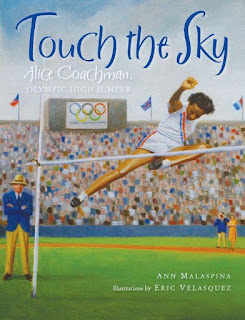 Recommended for ages 5-10. Young Alice Coachman, growing up in segregated Albany, Georgia, in the 1930's, just couldn't help herself. She wanted to soar and touch the sky. "Bare feet shouldn't fly./Long legs shouldn't spin./Braids shouldn't flap in the wind./'Sit on the porch and be a lady,' Papa scolded Alice," this book about the future Olympic athlete begins. When she watched boys doing the high jump at a track meet, "Alice's feet tingled, wanting to try." We see Alice's dreams growing bigger as she gets older, until finally the high school coach needed a jumper for a track and field tournament in Alabama. Her family was too poor to afford proper clothes for the competition, so her teachers pitched in and bought her shoes, shorts, and bright white socks. For the first time, she competed with the best black athletes in the South. In 1939, she won her first national medal, and soon she was asked to enroll at Tuskegee, where she'd be able to train with the best. Alice worked hard to pay her school fees. Alice dreamed of the Olympics, but with the world consumed by war there were no games to enter. Could she still compete in 1948? Would she achieve her dream of a gold medal in the high jump--and finally touch the sky? Written in a simple yet poetic style, this book captures the spirit of a true American heroine and a pioneer in sports, one who is not widely known today. It's a real "girl power" story, as well as a tale about overcoming prejudice. The stunning large format oil paintings, by illustrator Eric Velasquez, with their vibrant colors and sweeping compositions, capture the intensity of Alice's story, and especially of her jumping. An author's note shows photographs of the real Alice and her teammates and tells about what happened to Alice after her triumph at the Olympics. A bibliography is also included.
|




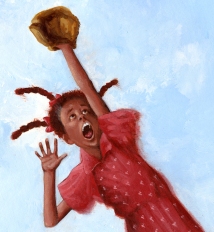



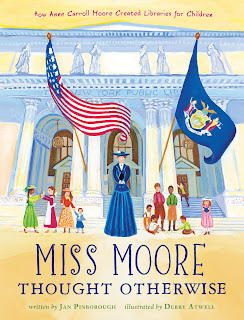


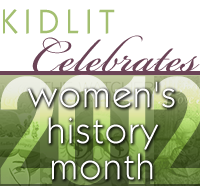





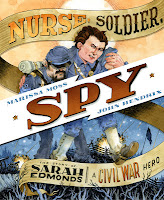


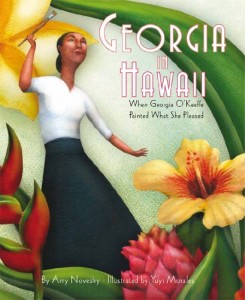
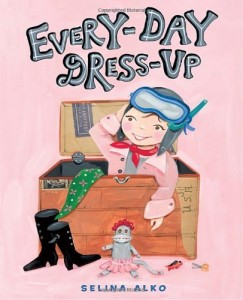
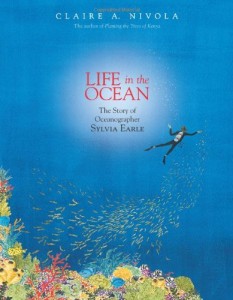

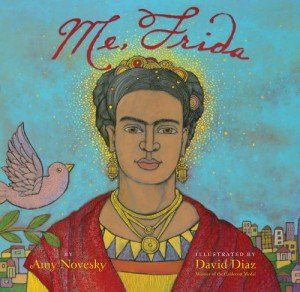


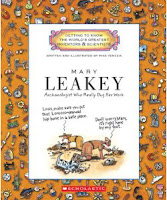


Thanks for sharing this information. There should be an equal treatment for men and boys.
[...] Women in Professional Baseball: “Diamonds are a girl’s best friend” [...]
[...] Women in Professional Baseball [...]